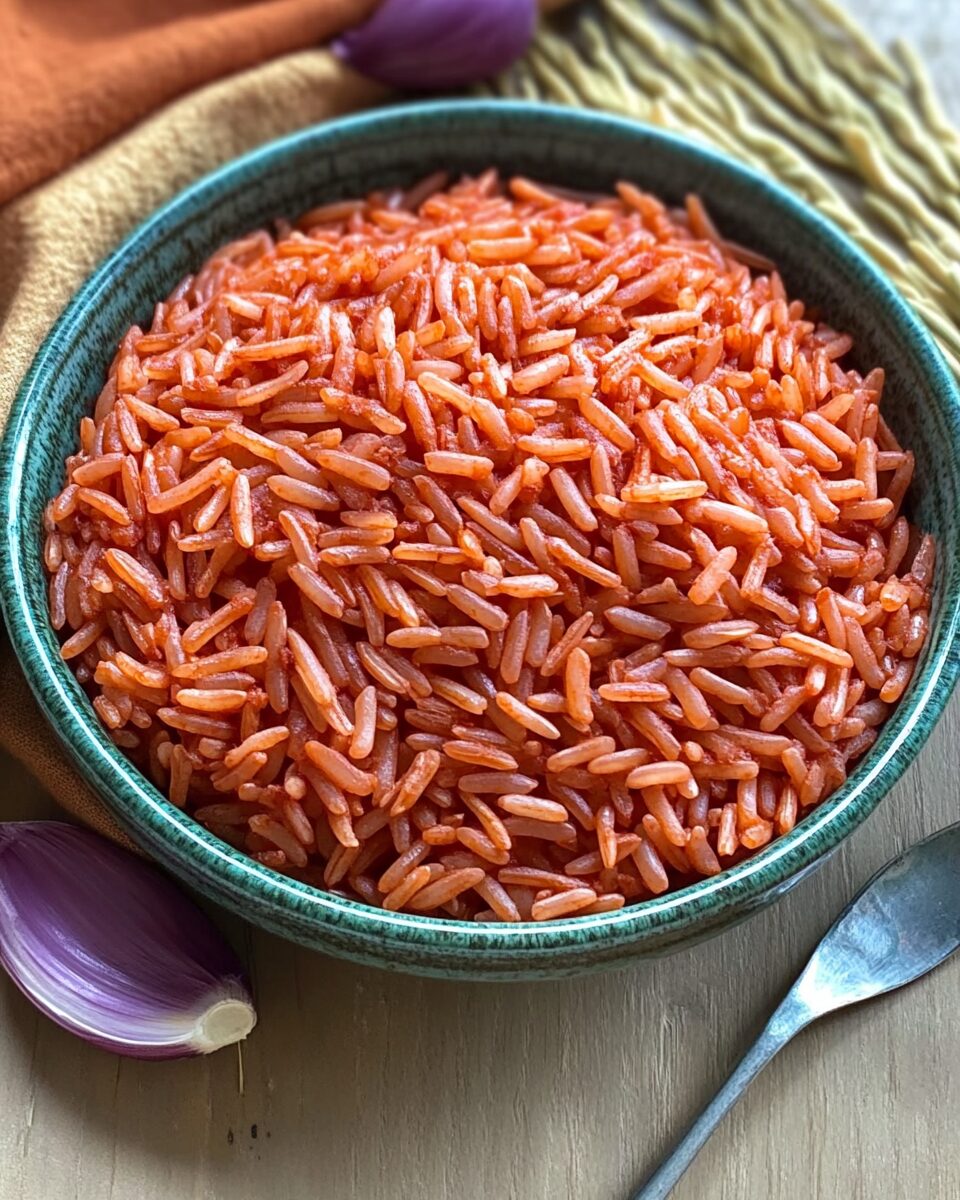The warmth of tomato, the kick of serrano chile, and the fragrant touch of cilantro make this Arroz Rojo the ultimate Mexican side dish. This beautifully hued rice is a staple in Latin American households, always ready to elevate tacos, grilled meats, or even a humble egg breakfast.
What makes this dish stand out is the toasting of the rice—a simple but game-changing technique that adds layers of flavor before the broth ever hits the pan. Whether you’re hosting a festive dinner or just craving authentic comfort food, this dish is easy to prepare, endlessly satisfying, and rich in tradition.
Full Recipe:
1 tablespoon vegetable oil
1 cup long grain white rice
1/3 cup finely chopped white onion
1 clove garlic, minced
2 1/4 cups chicken broth
3 tablespoons tomato paste
1 1/4 teaspoons kosher salt
1 serrano chile
1 fresh cilantro sprig
Directions:
In a large heavy saucepan, heat the vegetable oil over medium-high heat.
Add the rice, onion, and garlic, and sauté until the rice becomes opaque and fragrant—about 2 minutes.
Stir in the chicken broth, tomato paste, and kosher salt. Mix well until everything is evenly combined.
Add the serrano chile and cilantro sprig.
Cover the pan, reduce the heat to low, and simmer gently for about 30 minutes, or until the rice is fully cooked and has absorbed all the liquid.
Remove the chile and cilantro sprig. Fluff the rice with a fork and serve hot.
Prep Time: 10 minutes | Cooking Time: 40 minutes | Total Time: 50 minutes
Kcal: 210 kcal | Servings: 4 servings
The Cultural Significance of Mexican Red Rice (Arroz Rojo)
Mexican Red Rice, known as Arroz Rojo, is more than just a side dish—it’s a deeply rooted staple in Mexican culinary tradition. Often served alongside tacos, enchiladas, mole, grilled meats, or beans, this dish is a ubiquitous part of daily life and celebrations alike. In many households, it’s the first rice recipe children learn from their abuelas or mothers, often without written recipes but through memory and tradition.
What makes Arroz Rojo iconic is its rich color and subtle depth of flavor, achieved with simple ingredients that are foundational in Mexican kitchens: tomatoes, onions, garlic, and chicken broth. Yet, despite its simplicity, it delivers a complex, satisfying flavor and has a way of tying a meal together, adding warmth and comfort to any plate.
The Origins and Evolution of Arroz Rojo
The roots of Arroz Rojo trace back to the Spanish colonization of the Americas, when rice was introduced to Mexico from Asia via Spain. Over time, Mexican cooks adapted rice into their cuisine using local ingredients like tomatoes, chiles, and aromatic herbs. This fusion of Old and New World influences gave rise to a dish that is now as Mexican as tamales or tortillas.
While Arroz Rojo is often associated with home cooking, it’s found everywhere in Mexico—from market stalls to high-end restaurants. In each region, there may be slight variations in ingredients or preparation, but the spirit of the dish remains the same: comfort, nourishment, and cultural identity.
The Role of Tomato in Arroz Rojo
One of the defining characteristics of Arroz Rojo is its vibrant red hue, which comes from the tomatoes or tomato paste used during cooking. Tomatoes, indigenous to Mexico, are a cornerstone of Mexican cuisine and provide the dish with acidity, umami, and subtle sweetness. In some regions, fresh tomatoes are blended into a purée, while in others, tomato paste is favored for its convenience and concentration of flavor.
Regardless of the method, the tomato serves as more than just color—it harmonizes the flavors of garlic, onion, and broth to create a well-rounded profile that complements a wide array of main dishes.
Why Toasting the Rice Matters
A crucial but often overlooked step in making Arroz Rojo is toasting the rice before adding the liquid. This technique, inherited from Spanish and Middle Eastern influences, serves multiple purposes: it enhances the nutty aroma of the rice, prevents it from becoming mushy, and deepens the overall flavor of the dish.
As the rice turns from translucent to slightly golden, it absorbs the aromatic oils from sautéed garlic and onion, locking in a toasted essence that makes every bite more satisfying. This step, though simple, is a game-changer and is often what separates good Arroz Rojo from great Arroz Rojo.
Cilantro and Serrano Chile: Elevating the Aromatics
Though subtle, the addition of a fresh sprig of cilantro and a whole serrano chile during cooking introduces floral, herbal, and spicy notes that elevate the dish. These elements infuse the rice as it simmers, without overwhelming the palate.
The serrano chile is typically added whole, contributing heat without making the dish too spicy for most eaters. It also provides an optional flavor dimension for those who enjoy a bit more fire. The cilantro, on the other hand, lends an earthy, citrusy undertone that is both refreshing and classic in Mexican cuisine.
These ingredients reflect the holistic approach in Mexican cooking—where flavor isn’t just built on salt and fat, but on layers of herbs, aromatics, and thoughtful additions that complement one another.
Pairing Suggestions for Mexican Red Rice
Because of its balanced yet bold flavor, Arroz Rojo pairs beautifully with many main dishes. It’s often served as part of a comida corrida (set meal) alongside:
Chicken mole or tinga – The richness of the sauces plays beautifully against the light, fluffy texture of the rice.
Grilled carne asada – A robust pairing that balances charred meat with tomato-forward rice.
Fried eggs or huevos rancheros – Turning this “side” into a hearty breakfast.
Fried plantains and beans – For a vegetarian plate that’s comforting and protein-packed.
Its versatility means you can dress it up or keep it humble, and it never loses its charm.
Why Arroz Rojo Is a Family Favorite
One of the reasons Arroz Rojo remains a beloved dish across generations is its universality and adaptability. It’s gluten-free, budget-friendly, and can be made in large batches to feed a family. It’s also highly customizable—some families add peas, carrots, corn, or diced bell peppers to give it texture and variety.
In times of celebration or necessity, Arroz Rojo always finds a place at the table. Whether it’s for a birthday feast, a Sunday family meal, or a quick weeknight dinner, it satisfies the senses while connecting diners to cultural heritage.
It’s also an excellent dish for beginner cooks. Once mastered, it becomes a go-to recipe that never fails and can be memorized like a treasured poem.
Tips for Perfect Arroz Rojo Every Time
Use long grain white rice – It yields a light and fluffy result. Avoid short-grain or sticky rice, which can become too dense.
Control the heat – Once the liquid is added, reduce the heat and let it simmer gently. Avoid stirring, which can make the rice gummy.
Cover tightly – Letting steam escape can prevent the rice from cooking properly. A tight-fitting lid is key.
Rest before serving – After cooking, let the rice rest for a few minutes before fluffing with a fork. This allows excess moisture to evaporate and keeps the grains separate.
By following these basic principles, you’ll have consistent success and flavorful results every time you prepare Arroz Rojo.
Regional Variations of Mexican Red Rice
Although the core ingredients remain the same, Arroz Rojo can differ across Mexico’s vast culinary landscape:
In Northern Mexico, it’s often made with beef broth instead of chicken and includes diced vegetables.
In Central Mexico, it’s served more plainly as a traditional accompaniment to complex sauces like mole.
In Yucatán, achiote may be added for color and earthy flavor, giving it a slightly different profile.
Coastal regions might add shrimp or seafood stock, turning it into a more luxurious version.
These differences highlight how deeply regional cooking shapes even the most basic dishes in Mexico.
Arroz Rojo Around the World
Thanks to the global popularity of Mexican cuisine, Arroz Rojo has found a home in kitchens around the world. From Tex-Mex diners in the U.S. to Mexican fusion restaurants in Europe and Asia, red rice continues to evolve while retaining its heart.
It’s often served as part of combination plates or burrito bowls, acting as a foundation for bold proteins and fresh toppings. It also holds up well in meal prep, making it a favorite among busy home cooks who want flavor without compromise.
Conclusion: More Than Just a Side Dish
Mexican Red Rice (Arroz Rojo) is a dish that tells a story. It speaks of colonial fusion, family tradition, everyday resourcefulness, and timeless flavor. Its straightforward preparation hides a depth of cultural meaning and culinary technique that reveals itself with each forkful.
Though it may seem like a humble side dish, Arroz Rojo is anything but ordinary. It’s the embodiment of warmth, care, and history. Whether you’re preparing a feast or a simple meal, adding this dish to your table brings with it a piece of Mexico’s soul—and a whole lot of deliciousness.






